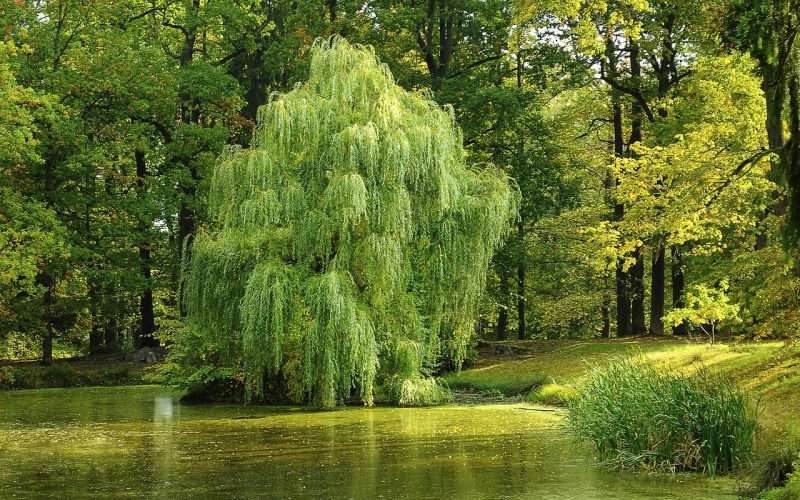Willow trees aren’t just beautiful, ornamental plants; they provide many practical benefits to people worldwide.
The Willow family includes more than 200 species and grows in almost every climate and soil type worldwide, making it one of Earth’s most widely distributed trees.
In addition, Willows are easy to grow and care for, making them an excellent choice for home landscaping projects. As well as other gardens and farms.
While there are many types of willow trees, this guide will show you how to select the best one for your needs based on the five most common types.
What is a Willow Tree?
A willow tree is a tree from the genus Salix. They are fast-growing trees and can quickly become overgrown if not adequately maintained. They range in height from 6 to 30 feet.
In addition, they have long, slender branches and leaves that are 2 to 6 inches long. The leaves are green on the top and white on the bottom.
The flowers are small and yellow or white. The fruit is a small capsule that contains seeds.
Categories of Willow Trees
Tree Willows
They are large shrubs or full-grown trees with prominent lancing leaves.
Sallows Willow
Sallows are the most common type of willow tree in North America and one of the hardest. They can grow in various soil types and climates, and they’re known for their fast growth.
Osier Willows
Also called basket willows, they are the most common type of willow used in living willow sculptures.
Different Types of Willow Trees
1. White Willow Tree
The white willow tree, also known as the European or the weeping willow, is a beautiful addition to any garden.
These different types of willow trees are known for their graceful weeping branches and ability to thrive in wet conditions.
Meanwhile, White willows can grow quite large, so ensure you have enough space before planting one.
These trees are also relatively short-lived, so be prepared to replant in a few years.
2. American Pussy Willow
The American pussy willow (Salix discolor) is a fast-growing, deciduous tree that can reach up to 30 feet tall.
It has narrow, lance-shaped leaves and produces small, fuzzy yellow-green flowers in the spring.
However, this tree is one of the different willow trees tolerant of a wide range of soils and prefers full sun to partial shade.
American pussy willows are often used as ornamental trees or as hedges.
3. Dwarf Willow
The Dwarf Willow is an excellent choice for a small, decorative tree. They only grow about six feet tall and have a weeping habit with slender, drooping branches. They are perfect for planting near water features or in containers.
4. Arctic Willow (Salix Arctica)
The Arctic willow is a small to medium-sized shrub native to the Arctic and Subarctic regions.
It has small, narrow green leaves on the top and white on the bottom.
These different willow trees are hardy plants that tolerate cold temperatures and poor soil conditions. It is often used as an ornamental plant in gardens.
5. Bebb Willow Tree
The Bebb willow tree is a medium-sized deciduous tree native to North America. It has a slender trunk and long, drooping branches.
Furthermore, the leaves are oval-shaped, and the flowers are yellow.
The Bebb has different types of willow trees that grow best in moist soils and can tolerate some flooding.
It is a popular garden choice because it is easy to care for and provides good shade.
6. Weeping Willow Tree
The weeping willow tree is a beautiful addition to any garden. But before buying one, you should know they can be high-maintenance.
Weeping willows are susceptible to several diseases and pests, and their branches can be fragile.
So if you’re looking for a low-maintenance tree, the weeping willow is probably not the right choice.
7. Corkscrew Willow Tree
The corkscrew willow tree, also known as Harry Lauder’s walking stick, is an ornamental willow. Its distinctive spiral-shaped branches give it its name.
These different willow trees are native to China and Japan but can be found in gardens worldwide.
The corkscrew willow is a deciduous tree that loses its leaves in the winter.
In addition, It’s a fast-growing tree that can reach up to 30 feet tall. A corkscrew willow is an excellent option if you’re looking for an eye-catching tree to add to your garden.
8. Narrowleaf Willow Tree
The narrow-leaf willow tree is a medium to large shrub that can grow up to 20 feet tall.
Its long, slender leaves are green on the top and white on the bottom. The flowers are small and yellow, and the fruit is a small blackberry.
Meanwhile, this tree is native to North America and can be found in wetland areas. It prefers full sun but can tolerate partial shade.
9. Dappled Willow Tree
The dappled willow tree, also known as Salix Integra, is a deciduous tree native to China and Japan. It loses its leaves in the fall and has a weeping habit.
The spotted willow grows about 20 feet tall and 15 feet wide. Its bark is orange-brown, and its branches are covered in small, round leaves.
The leaves turn yellow in the fall before they drop off. The dappled willow tree produces small, yellow flowers in the spring.
10. Peach-leaf
The peach-leaf willow tree is a fast-growing deciduous tree that can reach up to 50 feet tall.
Its dark green leaves turn yellow in the fall, and its branches are covered in small, pinkish-white flowers in the spring.
This tree is native to China and prefers full sun and moist soil. It’s a good choice for gardeners who want a quick-growing shade tree.
11. Goat Willow Tree
The goat willow tree, also known as the pussy willow, is a type of tree native to Europe and Asia. It gets its name from the soft, furry buds on the tree in early spring.
Goat willows are fast-growing willow trees that can reach up to 30 feet tall.
They are popular choices for gardens and landscaping because they are easy to care for and provide year-round interest.
12. Scouler’s Willow Tree
Salix scoulariformis, or Scouler’s willow, is native to western North America. It grows in various habitats, from wetland margins to dry hillsides.
This deciduous tree is named after the Scottish botanist William Scoular.
Its oval-shaped leaves and branches are covered in downy fuzz. The bark is smooth and brown. In early spring, yellow flowers bloom.
13. Crack Willow Tree
The crack willow tree, also known as the weeping willow, is a fast-growing tree that can reach up to 40 feet tall. It has long, drooping branches and leaves 2-5 inches long.
The crack willow tree is native to Europe and Asia and was introduced to North America in the early 1700s.
It is a famous tree for landscaping because it is easy to grow and maintain.
However, these different willow trees can be invasive, so plant them in an area that won’t spread.
14. Purple Osier
The purple osier willow tree, also known as Salix purpurea, is a popular type of willow tree.
Its bright purple branches and leaves make it a beautiful addition to any garden.
The purple osier willow tree is deciduous, meaning it loses its leaves in the winter.
It’s a fast-growing tree, reaching up to 15 feet tall in just a few years.
So, if you’re looking for a beautiful, fast-growing tree for your garden, the purple osier willow tree is a great option.
15. Yellow Willow Tree
The yellow willow tree, also known as Salix alba ‘Vitellina,’ is a beautiful, fast-growing tree that can reach up to 30 feet tall.
Its bright yellow branches and leaves make it a great addition to any garden.
Also, the yellow willow tree is one of the different types of willow trees that is tolerant of varying soil types and climates, making it easy to care for. However, it does require regular pruning to keep it looking its best.
Where are Willows Found?
Willows are found on every continent except Antarctica. In North America, there are more than 30 species of willows.
Europe has about 20 species, while Asia has more than 400. Willows can be found in various habitats, including wetlands, streams, and ponds.
Conclusion
In conclusion, there are many willow trees to choose from, depending on the size and style of your garden.
Weeping willows are a classic choice and provide beautiful shade and privacy.
But if you’re looking for something different, try a dwarf willow or one with colorful leaves.
No matter which type you choose, willows are easy to care for and make a stunning addition to any landscape.









I have a dwarf willow tree. It’s in my apartment, inside of the French doors, off the balcony. I’ve had it for 10 months. It was thriving. It got new shoots and the pot is large enough for it’s roots. It went through seasons where it had leaves and the pussy willows, but now in early November it just looks like barren sticks. Does it go through a season like this? I’m imaging that in spring (February) it will bud again, but I am not sure.